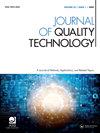Controlling the conditional false alarm rate for the MEWMA control chart
IF 2.2
2区 工程技术
Q2 ENGINEERING, INDUSTRIAL
引用次数: 8
Abstract
Abstract An integral part of the design of control charts, including the multivariate exponentially weighted moving average (MEWMA) control chart, is the determination of the appropriate control limits for prospective monitoring. Methods using Markov chain analyses, integral equations, and simulation have been proposed to determine the MEWMA chart limits when the limits are based on a specified in-control average run length (ARL) value. A drawback of the usual approach is that the conditional false alarm rate (CFAR) for these charts varies over time in what might be in an unexpected and undesirable way. We define the CFAR as the probability of a false alarm given no previous false alarm. We do not condition on the results of a Phase I sample, as done by others, in studies of the effect of estimation error on control chart performance. We propose the use of dynamic probability control limits (DPCLs) to keep the CFAR constant over time at a specified value. The CFAR at any time, however, could be controlled to be any specified value using our approach. Using simulation, we determine the DPCLs for the MEWMA control chart being used to monitor the mean vector with an assumed known variance-covariance matrix. We consider cases where the sample size is both fixed and time-varying. For varying sample sizes, the DPCLs adapt automatically to any change in the sample size distribution. In all cases, the CFAR is held closely to a fixed value and the resulting in-control run length performance follows closely to that of the geometric distribution.控制MEWMA控制图的条件虚警率
控制图的设计,包括多变量指数加权移动平均(MEWMA)控制图的设计,一个不可缺少的部分是确定适当的控制范围,以进行前瞻性监测。提出了利用马尔可夫链分析、积分方程和仿真的方法来确定MEWMA图的极限,当极限基于指定的控制平均运行长度(ARL)值时。通常方法的一个缺点是,这些图表的条件虚警率(CFAR)可能会以一种意想不到的、不希望看到的方式随时间变化。我们将CFAR定义为在没有先前虚警的情况下出现虚警的概率。在研究估计误差对控制图性能的影响时,我们不像其他人那样以第一阶段样本的结果为条件。我们建议使用动态概率控制限制(DPCLs)来保持CFAR随时间恒定在一个指定的值。但是,可以使用我们的方法将任何时候的CFAR控制为任何指定的值。通过仿真,我们确定了MEWMA控制图的DPCLs,该控制图用于用假设已知的方差-协方差矩阵监测均值向量。我们考虑样本量既固定又随时间变化的情况。对于不同的样本量,dpcl可以自动适应样本量分布的任何变化。在所有情况下,CFAR都保持在一个固定值附近,由此产生的受控运行长度性能与几何分布密切相关。
本文章由计算机程序翻译,如有差异,请以英文原文为准。
求助全文
约1分钟内获得全文
求助全文
来源期刊

Journal of Quality Technology
管理科学-工程:工业
CiteScore
5.20
自引率
4.00%
发文量
23
审稿时长
>12 weeks
期刊介绍:
The objective of Journal of Quality Technology is to contribute to the technical advancement of the field of quality technology by publishing papers that emphasize the practical applicability of new techniques, instructive examples of the operation of existing techniques and results of historical researches. Expository, review, and tutorial papers are also acceptable if they are written in a style suitable for practicing engineers.
Sample our Mathematics & Statistics journals, sign in here to start your FREE access for 14 days
 求助内容:
求助内容: 应助结果提醒方式:
应助结果提醒方式:


